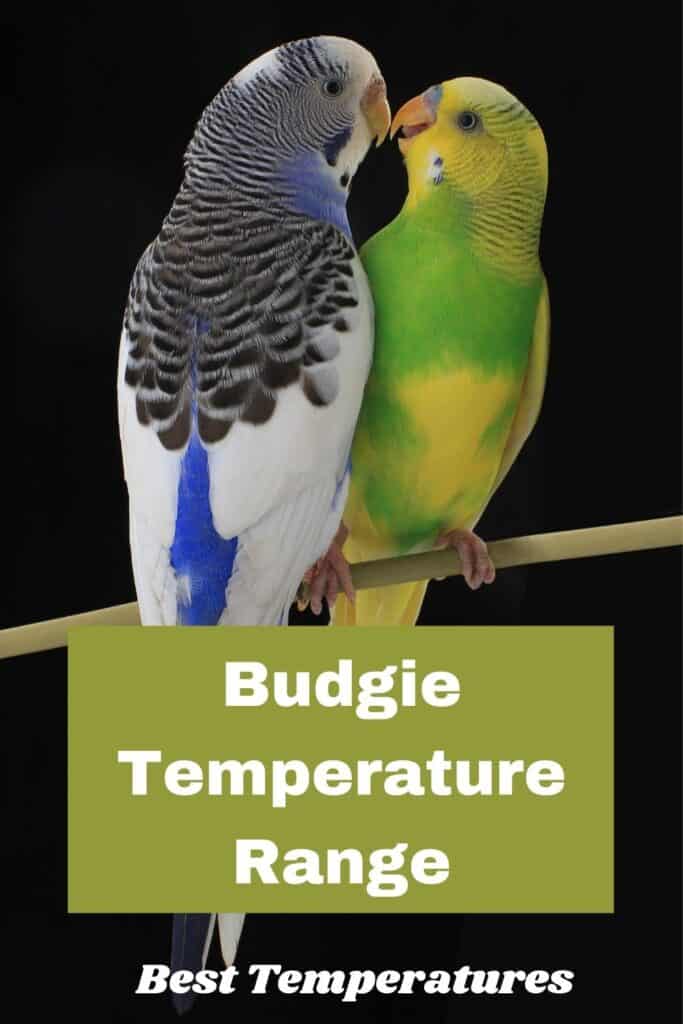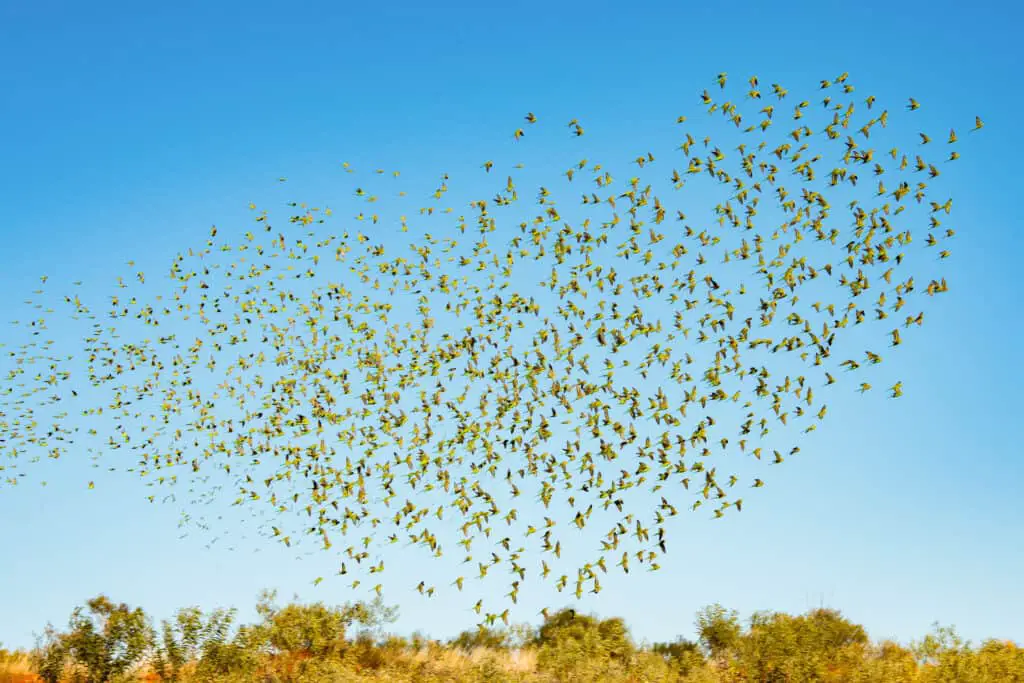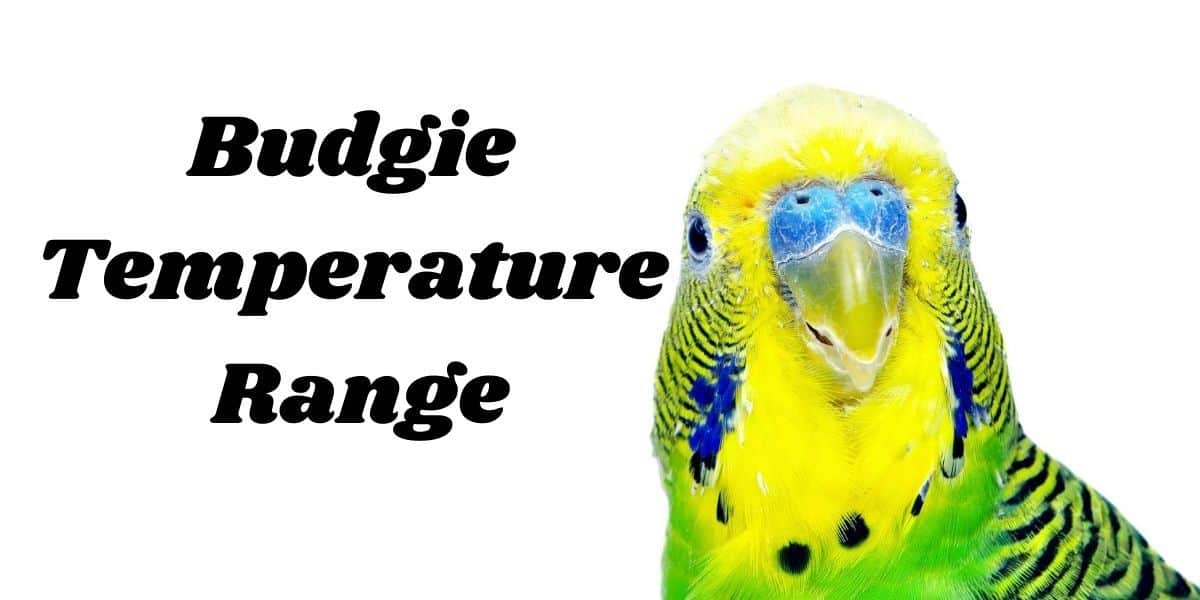Something that many fishkeepers and dog owners are constantly aware of is the temperatures of the pet’s environment.
It’s well documented that certain fish need certain temperatures and that dogs can be prone to overheating (hence leaving the window down in cars).
One thing that many pet owners take for granted, however, is the ideal temperature for their birds and in particular budgies.
This is not due to negligence by the owner but rather based on the fact that unless modifications are made to the cage, our budgies are being subjected to room temperatures that we set for our own comfort levels.
Budgies are warm climate birds and need an ideal temperature range of 70 – 75 degrees Fahrenheit to be comfortable at all times. As budgies are tropical birds that have migrated, they are not best suited to the cold and you should never subject them to temperatures below 60 degrees or subject them to harsh 20 degree shifts in temperature at any one moment.
Budgies can have subtle, yet telltale signs that they are either too cold or too hot and in this article, we’ll discuss the key topics when it comes to setting the ideal temperature for your budgie year-round.

Table of Contents
Budgie Temperature Range
Budgies in general are best suited to very moderate temperatures that offer little fluctuation.
A temperature of 70 degrees Fahrenheit is a typically accepted average temperature that is seen as ideal for most budgies, this also allows for some flexibility and they can comfortably live at temperatures anywhere from 60 – 80 degrees Fahrenheit as long as you monitor their comfort level.
Budgies are warm-weather birds and originated from the hot deserts and tropical forests of Australia so they are definitely better suited to a warm climate than a cold one.
The key thing to note is that budgies are not well suited to drastic changes in temperature and going from 70 degrees to 40 degrees for example could pose a serious risk to your pet.
The same is true at the other extreme and a drastic switch to a very hot temperature could likewise be very problematic.
Signs That You Need to Adjust the Temperature for Your Budgie
When monitoring temperature, especially when outside temperatures range to the extremes, it’s important to look out for some obvious (and not so obvious) signs that your budgie is in discomfort as a result of extreme temperatures.
Budgies that have adapted to certain temperatures will have specific features that allow them to remain comfortable.
This could include more feathers for the cold or less for hotter climates and in general, they can cope well with moderate temperature changes for short periods of time.
As they don’t typically have a lot of feathers to maintain warmth and also don’t have sweat glands to cool down, the signs of discomfort can be universal amongst budgies. The signs to look out for are:
- Too hot – a budgie that is too hot will open its beak and spread its wings in an effort to release heat into the atmosphere. You should also notice they do not move around as much in an effort to reduce body temperature rising further and they might also try to cool themselves down in a birdbath or if in direct sunlight, seek shade (which is likely not an option in a cage).
- Too cold – a budgie that is too cold will puff its feather up in an effort to maintain as much body heat as possible and you’ll also notice them shivering. Those that have adapted to have fewer feathers due to a typically hotter climate will be substantially more vulnerable in cold temperatures. They will also seek shelter in a built-in birdhouse (again if this is something you’ve provided in your cage) in an effort to escape the cold.
Some long-term signs to look out for are budgies molting which means they will be too hot most of the time so are doing this to cool down and also frequent panting (again a sign of them being too hot).
Changing Seasons and Managing Your Budgies Temperature
Once you know what to look out for in a budgie struggling due to the temperature (points above) it’s important to set a temperature range and then manage your budgies temperature based on seasonal changes.
It’s also helpful to occasionally subject your budgies to outside temperatures both for some fresh air to enjoy nature but also to help them acclimatize to changing temperatures.
Budgies originate from Australia in the desert and tropical climates so they are not unaccustomed to freezing temperatures at night and can cope with the heat well by seeking shade and water sources.
The only issue is that they have adapted to survive in these climates whereas being kept in captivity as a pet does not offer this level of flexibility or resourcefulness, they rely on their owner!.
Therefore you’ll need to manage your budgie’s temperature by having a range of tools and tactics at your disposal during both the hot and cold seasons.

Hot Weather Management
During heat waves, it’s important to keep your budgies cool as they do not have sweat glands to help regulate their body temperature, this increases the chance of heatstroke which can set in as quickly as 15 minutes so prior preparation is essential.
A fan will circulate cool air to prevent them from breathing in too much warm air (though placed directly on them wouldn’t be advised for long periods as their feet and beak will dry out).
An upgrade to home air conditioning will of course allow you to perfectly control the room temperature regardless of outdoor temperatures (though this can be costly initially and again doesn’t replicate the moist atmosphere that they like).



You’ll, therefore, need to provide an air moisture source as dry air can cause the birds to suffer from dry skin, feet and beaks as mentioned above.
If you don’t have something to do this automatically, then spraying water over the change every few hours will help supply your budgies with some much-needed moisture.
A birdbath can also be great for both cooling down and also providing moisture but with this option, ensure that the birdbath is separate from the bird’s freshwater drinking source and ensure that they are not getting the two confused.
Cold Weather Management
Cold weather for most is easier to manage as there are currently specially made products that are designed to keep a budgie’s cage warm.
Firstly, ensure the environment is sealed and free from drafts, an open window might seem like a good source of fresh air for your budgies but if it’s too cold it will more than likely cause complications.
Next, ensure the budgies have a form of shelter such as a small birdhouse which would free them from cold winds if kept outside and also give them somewhere to maintain body heat rather than being out in the open.
You’ll also want to keep your budgie’s cage warm with a variety of options.
A cage specific heater like the K&H thermal perch will help you maintain heat in a small surface area (rather than trying to heat the whole room), a heated perch will also be great.
Heated solar bulbs let off just enough heat to keep your budgies warm without ever posing a fire or overheating risk.
Lastly, you’ll want to provide a cage cover to trap in the heat during steep temperature drops or during the night, you can purchase specially made covers but a towel or blanket can also work just as well.
You can also check out this helpful YouTube video which nicely sums up ways to keep your budgie’s cage warm.
Bottom Line
Generally, if the temperature is too uncomfortable for a human then it is likely too uncomfortable for a budgie.
Keeping a comfortable and consistent temperature is crucial for your budgies’ health and happiness and anywhere between 65 – 75 degrees is going to be ideal for them on a consistent basis.
While they can adapt to temperature changes over time, it’s important to note that changes of more than 20 degrees, either way, could pose your budgie serious issues and this should be avoided at all costs.






